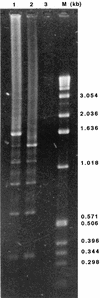Molecular characterization of Mycoplasma arthritidis variable surface protein MAA2
- PMID: 9596719
- PMCID: PMC108241
- DOI: 10.1128/IAI.66.6.2576-2586.1998
Molecular characterization of Mycoplasma arthritidis variable surface protein MAA2
Abstract
Earlier studies implied a role for Mycoplasma arthritidis surface protein MAA2 in cytadherence and virulence and showed that it exhibited both size and phase variability. Here we report the further analysis of MAA2 and the cloning and sequencing of the maa2 gene from two M. arthritidis strains, 158p10p9 and H606, expressing two size variants of MAA2. Triton X-114 partitioning and metabolic labeling with [3H]palmitic acid suggested lipid modification of MAA2. Surface exposure of the C terminus was indicated by cleavage of monoclonal antibody-specific epitopes from intact cells by carboxypeptidase Y. The maa2 genes from both strains were highly conserved, consisting largely of six (for 158p10p9) or five (for H606) nearly identical, 264-bp tandem direct repeats. The deduced amino acid sequence predicted a largely hydrophilic, highly basic protein with a 29-amino-acid lipoprotein signal peptide. The maa2 gene was expressed in Escherichia coli from the lacZ promoter of vector pGEM-T. The recombinant product was approximately 3 kDa larger than the native protein, suggesting that the signal peptide was not processed in E. coli. The maa2 gene and upstream DNA sequences were cloned from M. arthritidis clonal variants differing in MAA2 expression state. Expression state correlated with the length of a poly(T) tract just upstream of a putative -10 box. Full-sized recombinant MAA2 was expressed in E. coli from genes derived from both ON and OFF expression variants, indicating that control of expression did not include alterations within the coding region.
Figures






References
-
- Anderson B, McDonald G. Construction of DNA libraries of A-T rich organisms using EcoRI star activity. Anal Biochem. 1993;211:325–327. - PubMed
-
- Ausubel F M, Brent R, Kingston R E, Moore D D, Seidman J G, Smith J A, Struhl K, editors. Current protocols in molecular biology. New York, N.Y: John Wiley & Sons, Inc.; 1993.
-
- Bhugra B, Voelker L L, Zou N, Yu H, Dybvig K. Mechanism of antigenic variation in Mycoplasma pulmonis: interwoven, site-specific DNA inversions. Mol Microbiol. 1995;18:703–714. - PubMed
Publication types
MeSH terms
Substances
Associated data
- Actions
- Actions
- Actions
Grants and funding
LinkOut - more resources
Full Text Sources
Miscellaneous

